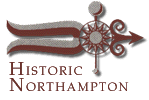

|


Abolitionism

Anti-slavery societies were formed in Massachusetts beginning in 1780. Abolitionists made regular visits to Florence and included Lydia Maria Child, Frederick Douglass, William Lloyd Garrison, Sojourner Truth, the Tappans and Wendell Phillips.
In the antebellum years, Northampton and Florence played their part in the flow of the Underground Railroad. Routes from Connecticut continued to Springfield and Westfield to stations and depots in Northampton and Florence. From there, the railroad continued to Cummington, Whately, Deerfield and Greenfield.
Because of secrecy at the time, information about stations and station masters remains unconfirmed. James Payson Williston had a reputation of knowing more about the railway and contributing more money in its support than anyone in town. His residence was located at the corner of Maple and Pine streets in Florence. According to Arthur Hill, the residence of his father, Samuel Hill, also served as a stop. Other operators included A.P. Critchlow at his factory on Pine Street, Samuel Bottum at his residence on Main Street in Florence and Austin Ross at the Ross Farm on Meadow Street in Florence. Local tradition also suggests the 1850s Bridge Street home of Seth Hunt, treasurer of the Connecticut River Railroad and known for being a free thinker.
The "Hampshire Herald," an abolitionist, Liberty Party newspaper was published in Northampton between 1846 and 1848.
In 1842, members of the Northampton Association of Education and Industry established a utopian community organized around a communally owned and operated silk mill. Those who were drawn to this community sought to challenge the prevailing social attitudes of their day by creating a society in which "the rights of all are equal without distinction of sex, color or condition, sect or religion." They were especially united around the issue of the abolition of slavery. Most were followers of William Lloyd Garrison. Sojourner Truth was a member of the community and visitors like Frederick Douglass were regular lecturers.
Although most in Northampton opposed slavery, few espoused the egalitarian notions of the Garrisonians. Indeed, Northampton was a popular summer destination for wealthy Southern planters and their families. True, the underground railroad listed a number of stations in the area, but abolitionist Lydia Maria Child wrote in despair of the indifference of "this iron-clad valley of the Connecticut."
The 1845 Catherine Linda case, in which a slaveholder's rights were confirmed by a Northampton court, is a case in point.
Lydia Maria Child lived in Northampton from 1836 until 1841 when she went to New York as editor of the National Anti-Alavery Standard (shown above).
Also see An Abolitionist Utopia: Northampton Association of Education and Industry (1842-1846).
Contents Historic Northampton.